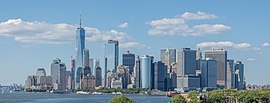
Mid-Atlantic (United States)
Region of the United States / From Wikipedia, the free encyclopedia
Dear Wikiwand AI, let's keep it short by simply answering these key questions:
Can you list the top facts and stats about Mid-Atlantic (United States)?
Summarize this article for a 10 years old
The Mid-Atlantic is a region of the United States located in the overlap between the Northeastern and Southeastern states of the United States. The region typically includes the five states of New York, New Jersey, Pennsylvania, Delaware, and Maryland, as well as the District of Columbia, and occasionally Virginia and West Virginia.
Mid-Atlantic | |
|---|---|
|
Left to right from top: Lower Manhattan skyline, Independence Hall in Philadelphia, Assateague Island, the skyline of Philadelphia, the Catskills seen from the Hudson River, Downtown Pittsburgh, Jersey City, and the Washington Monument, Jefferson Memorial, and Washington, D.C. skyline | |
 U.S. states always considered Mid-Atlantic states are indicated in dark red; states sometimes considered Mid-Atlantic are indicated in pink. | |
| Coordinates: 41°N 77°W / 41; -77 | |
| Composition | |
| Metropolitan areas | |
| Largest city | New York |
| Area | |
| • Total | 191,299.86 sq mi (495,464.4 km2) |
| • Land | 174,468.45 sq mi (451,871.2 km2) |
| • Water | 16,831.41 sq mi (43,593.2 km2) 8.80% |
| Population | |
| • Total | 60,783,913 |
| • Density | 320/sq mi (120/km2) |
| GDP (nominal) | |
| • Q3 2022 | $5.233 trillion |
The Mid-Atlantic region played an instrumental and historic role in the nation's founding and the development of the nation. Each of the seven states were members of the Thirteen Colonies that gathered in Philadelphia during the Second Continental Congress, which unanimously adopted the Declaration of Independence in 1776, formalized the Continental Army under George Washington's command that escalated and ultimately won the American Revolutionary War over British colonialists. Following independence, the states again gathered in Philadelphia at the Constitutional Convention, where, in 1788, they ratified the United States Constitution, which remains the oldest and longest-standing written and codified national constitution in force in the world today.[3]
The Mid-Atlantic region was settled during the colonial era between the early 17th century and the conclusion of the American Revolutionary War in 1783 by European Americans of primarily Dutch, German, Swedish, English, and other Western European ethnicities. Religious pluralism and freedoms existed in the original Thirteen Colonies and were particularly prevalent in Province of Pennsylvania and the geographic region that ultimately broke from Pennsylvania to form the Delaware Colony. Among the 13 original colonies, the Province of Maryland was the only colony with a substantial Catholic population.
Following the American Revolutionary War, the Mid-Atlantic region hosted each of the historic capitals of the United States. The nation's capital was constructed in Washington, D.C., and relocated there from Philadelphia following its completion in 1800. In the early part of the 19th century, New York and Pennsylvania overtook Virginia as the most populous states and overtook New England states as the country's most important trading and industrial centers. Large numbers of German, Irish, Italian, Jewish, Polish, and other immigrants transformed the region, especially coastal cities, including New York City, Newark, Philadelphia, Baltimore, and interior cities such as Pittsburgh, and Rochester, Albany, and Buffalo, with their skyscrapers and subways, which emerged as icons of modernity and American economic and cultural power in the 20th century. By the 21st century, the coastal areas of the Mid-Atlantic were thoroughly urbanized.
In the late 19th century, the region played a vital and historic role in the development of American culture, commerce, trade, and industry sectors. It was labeled "the typically American" region by historian Frederick Jackson Turner.[4]
The Northeast Corridor and Interstate 95 link an almost contiguous sprawl of suburbs and large and small cities, forming the Mid-Atlantic portion of the Northeast megalopolis, one of the world's most important concentrations of finance, media, communications, education, medicine, and technology. The Mid-Atlantic is a relatively affluent region of the nation, having 43 of the 100 highest-income counties in the nation, based on median household income, and 33 of the top 100, based on per capita income. Most of the Mid-Atlantic states rank among the 15 highest-income states in the nation, by median household income and per capita income.
The region is home to eight of the top twenty-five ranked universities in the nation: Cornell University in Ithaca, NY, Columbia University and NYU in New York City, Princeton University in Princeton, New Jersey, the University of Pennsylvania in Philadelphia, Carnegie Mellon University in Pittsburgh, Johns Hopkins University in Baltimore, and Georgetown University in Washington, D.C., according to U.S. News & World Report's 2022-23 College Ranking.[5][6]



.jpg/270px-Philadelphia_skyline_from_South_Street_Bridge_January_2020_(rotate_2_degrees_perspective_correction_crop_4-1).jpg)



